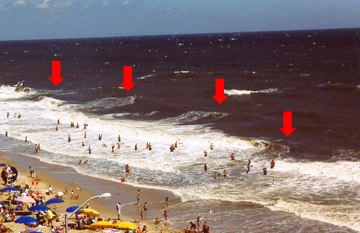Tens of millions of people visit Florida’s beaches every year, and most of them come away with nothing worse than a sunburn. Yet the beaches can be hazardous – especially those in the Panhandle. They claim about half of all the lives lost in the United States to rip currents – strong flows that can carry swimmers out to sea.
 Crowded beach, showing rip currents. Credit: Delaware Sea Grant
Crowded beach, showing rip currents. Credit: Delaware Sea GrantScientists are trying to understand why that’s the case. Their research suggests that it’s a combination of the beaches themselves, large crowds, poor swimmers, and a lack of knowledge about rip currents.
Rip currents form as water pushed ashore by wind and waves moves back out to sea. It moves through cuts in sandbars, forming swift, narrow channels. The sandbars off the beaches of the Florida Panhandle lead to strong, frequent rip currents. The currents are especially nasty in spring and summer, when stronger sea breezes create stronger currents. That’s also when most people visit the beaches.
There are a few signs for spotting a rip current. It’s often calmer than the surrounding water, and objects floating in the current are moving away from shore. Yet many beachgoers are unaware of those and other signs. In fact, many actually pick a spot on the beach that’s next to a rip current. The combination leads to about a score of deaths each year.
Experts suggest that you observe all warning signs, have a buddy on-shore to keep an eye on you, and swim on beaches with lifeguards. That can help make sure that a day at the beach is – well, like a day at the beach.
This episode of Science and the Sea was made possible by Texas Sea Grant.

